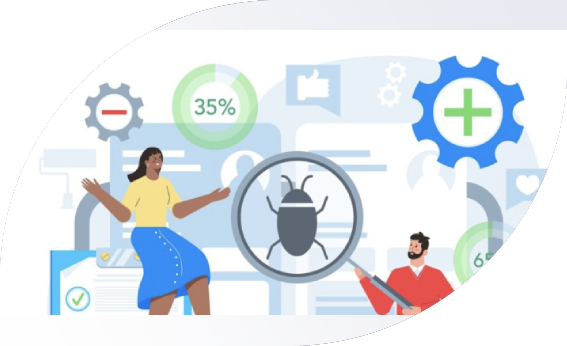Manual & Automation Testing
Think like a user, act like a detective, and deliver like a perfectionist.

Course Duration: 12 Weeks
What you'll learn
Software testing is a comprehensive discipline that equips you with critical skills and knowledge to ensure the quality, reliability, and usability of software. Here’s a detailed description of what you can learn in testing:
Planning and Preparation
- Define Testing Objectives: Understand the purpose of testing, such as finding defects or verifying performance
- Analyze Requirements: Review the software requirements and design documents
- Identify test objectives, scope, and schedule Define roles, responsibilities, and resource allocation Determine the types of testing (e.g., functional, performance, security)
Designing Test Cases
- Write Test Scenarios: Broad-level actions to validate specific requirements
- Create Test Cases: Detailed steps for executing a test scenario, including Input data Expected results Pre-conditions Post-conditions
- Test Data Preparation: Identify and prepare the data required for testing
Test Environment Setup
- Configure Test Environment: Set up the hardware, software, network, and tools required for testing
- Verify the Environment: Ensure the environment mimics real-world conditions as closely as possible
- Prepare Test Tools: Install and configure tools like Selenium, JIRA, or Postman
Test Execution
- Execute Test Cases: Follow the steps outlined in the test cases and log the results
- Track Defects Log bugs in a defect-tracking tool Provide detailed information (steps to reproduce, environment details, screenshots)
- Retest and Regression Testing: Verify defect fixes and ensure new code changes haven't introduced additional issues.
Test Reporting
- Create Test Summary Reports
- Test cases executed
- Pass/fail rates
- Defects identified and resolved
- Outstanding risks
- Provide Recommendations: Offer insights on software readiness and areas for improvement.
- Communicate with Stakeholders: Share test results with the development team, project managers, and clients.
Test Closure
- Evaluate Exit Criteria: Ensure all planned tests are executed and critical defects are resolved
- Document Learnings: Compile lessons learned, challenges faced, and process improvements
- Archive Test Artifacts: Store test plans, cases, data, and reports for future reference
Best Practices in Software Testing
- Early Testing: Start testing early in the development cycle to catch defects sooner
- Automate Where Possible: Use automation for repetitive tasks to save time and reduce errors
- Focus on User Perspective: Test the application as if you are the end user
- Maintain Clear Communication: Collaborate effectively with developers and stakeholders
- Continuous Improvement: Regularly update test processes based on feedback and results
Common Tools for Software Testing
- Test Management: TestRail, Zephyr, qTest
- Bug Tracking: JIRA, Bugzilla, Mantis
- Automation Testing: Selenium, Cypress, Appium
- Performance Testing: JMeter, LoadRunner, Apache Bench
- API Testing: Postman, SoapUI, RestAssured
Challenges in Software Testing
- Ambiguous requirements
- Limited testing time
- Constantly evolving technology
- Reproducing intermittent bugs
- Ensuring comprehensive test coverage
- Solution: Focus on clear communication, prioritization, and leveraging tools effectively
Roadmap for Learning Software Testing
- Understand the basics (types of testing, SDLC/STLC)
- Learn test case creation and defect tracking
- Master tools for manual and automated testing
- Practice testing real-world applications
- Stay updated on trends like AI-driven testing and DevOps integration
Join Us Today
Let’s build the future together. Explore our courses, enhance your skills, and unlock new opportunities in the ever-evolving tech industry. At Sri Saadhana Solutions, your success is our priority.
